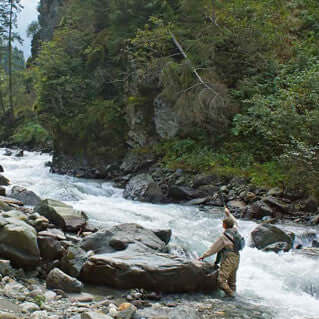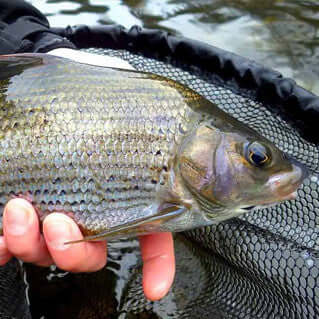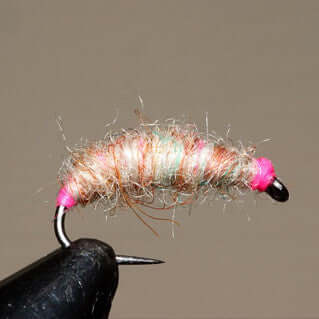The first time my fishing buddy Steve & I visited the high alpine streams of Austria, in July of 2007, we were overawed by the speed & turbulence of the flows. How does one fish a maelstrom of white water? Moreover, how could fish survive in such fast water, particularly during the major snow-melt of spring? Inevitably we fished the few slower sections of river, those places that were most like what we were used to & for which we had tactics that worked. We caught quite a few fish but we realized that we were well out of our comfort zone.

Pocket water, Austria
Faster, pocket water
In 2008, after a bit of thought, we started to get our act together & began to push the boundaries of what we thought was possible. I thought back to a 2000 mile cycle trip through the Yukon & Alaska that I had done in the year 2000. There I had fished for grayling in Brushkana Creek on the Denali Highway. The water was so fast that my only option with my 8’ travel rod was to fish the tiny marginal pockets by dropping a nymph into them then lifting after it had had time to sink. The result was a pleasing number of small grayling. Consequently we started fishing faster, pockety areas on the Austrian rivers using 10’ 4 weight rods, close range high-sticking with just a 14’ leader & a few feet of fly line out of the rod tip. This allowed us to hold most of the leader & tippet out of the fast water whilst our flies were in the small pockets of water in front of & behind the abundant rocks. As for flies we opted for big, buoyant, highly visible dry flies (size 10 Hi-vis Klinkhamers & Hi-vis Daddies). Our resultant catches increased five fold & we caught fish in water that we would never have considered fishing before.
Tenkara
In November of 2010 I came across Tenkara & having watched some of the videos on the Tenkara USA website I realized that Tenkara was not just an old fashioned Japanese style of fishing but that it was an elegant, refined & more efficient means of achieving what we’d been doing with our long Western rods. Our 2011 Austrian trip was a revelation. The line control & fly control that we could effortlessly achieve with our 14’ 7” Tenkara rods, 11’ of 0.35mm Copolymer line & 3 to 4’ of 5x tippet, plus a big dry fly was a revelation. We could hold a fly as long as we wanted in the middle of a tiny calm pocket & if no fish rose to our offering just by tapping the butt with a forefinger we could ‘dance’ & twitch the fly on the surface to induce a take. We could drift our fly at snail’s pace down the narrow strip of slow water next to the far bank, holding all our line & tippet off the racing flow a few inches out from the bank. Furthermore it was easy to accurately & forcefully plop our offering, fly-first, onto the water to let the fish know food had arrived. Our joy was unbounded & our catches astronomic, even embarrassing as folks though that we were lying about how many fish we’d caught & where we’d caught them.

Typical alpine brownie.
Buoyant flies
0.285mm fluorocarbon (or in windy conditions super-fine titanium lines) & we now tend to use hyper-buoyant foam flies (size 12 & 14 longshank Chernobyl Ants & size 12 Foam Black Beetles) since in turbulent water, when the fish are coming thick & fast much time can be wasted applying floatant to less buoyant patterns. However there are times even on these food-poor, fast flowing streams that a fall of Ants or hatch of small Olives dictates the use of smaller flies if success is to be achieved.
The most exciting part of this kind of fishing is catching fish from the most extreme places, the tiniest pockets in the most chaotic flows, particularly if you’re with a friend as happened in 2012 with myself & Stu Crofts trying to outdo each other by fishing more & more ridiculous spots. It has become a real journey of exploration for us. Probably the most rewarding part is introducing friends to what can be achieved & watching their amazement. Last September I was in the Sarca Valley in Northern Italy with the FFM UK Italian Casting Team. The Italian Style of casting evolved to cope with the problems of fishing dry flies in alpine streams but not the high, turbulent flow that we encountered in the headwaters of the Sarca. Steve & I introduced several of the guys to the magic of Tenkara & they just couldn’t believe where we caught fish from or the size of the Foam flies that we were using.

Brook Trout.
Summer melt
Things to be aware of in the Alps are the possibility of meltwater & colouration in the summer (particularly after midday) on streams fed by glaciers, summer thunderstorms & the chance of snow at any time of year, plus long steep walk-ins to some of the best fishing. We usually go in September to avoid the worst of the summer melt.
I love challenging fishing since it always stretches me & I learn so much by doing it. In my next blog I’ll tell you about the challenge of fishing deep under overhanging trees & on overgrown, ‘Jungle Warfare” brooks, using the Italian Style of casting.
 Dry Fly fishing, September Austria.
Dry Fly fishing, September Austria.
































